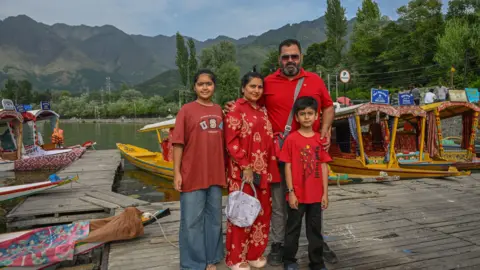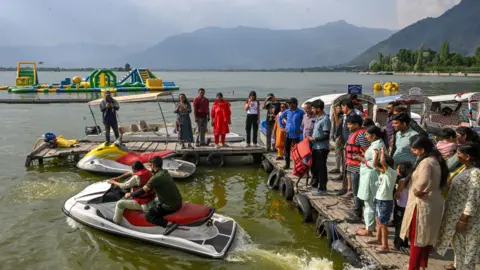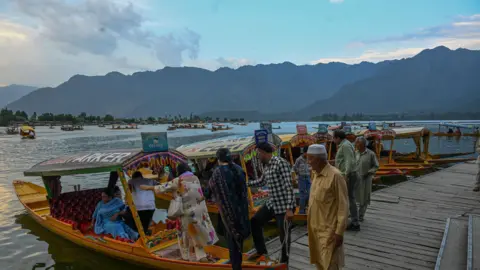 Abid Bhat
Abid BhatTwo months after a deadly attack in Indian Cashmir, he frightened tourists and brought India and Pakistan on the Ivik of war, the picturesque valley in the Himalayal Mountains will begin to see the first signs of reviving tourism.
Shabana Avval makes videos about his children while turning on the water bike to water on Dal Lake, the most official tourist video of Srinagar City.
Mrs. Avval traveled from the western state of Rajasthan with her husband and children in a group of 15 – all members of their extended family.
“I visited Kashmir many times and saw all the main attractions such as Gulmarg, Sonmarg and Pahalgam and wanted to show all those places to my cousins,” she says BBC.
Avals planned their 10-day trip in March. “Summer in Rajastan is unbearably hot, so we would plan to escape to Kashmir during a children’s school vacation,” she says.
But since she planned the journey, the circumstances had changed drastically here. 22. April militants attacked tourists who visited beauty near the city of Pahalgam, killing 26 men.
Tourism is the main setting of economy Jammu and Kashmir, territory with the federally applied, and that innocent targeting tourists sent Shockkvasses through India. The authorities closed 48 tourist destinations in the valley, and two thirds remain closed.
Main Minister Omar Abdullah, who was hardly hungively to open these points to attract visitors in the region, says “The impact of the attack was current and very felt”.
“There was a massive exodus of these tourists who were already here and the mass cancellation of those who suggested Arrival and Pakistan, for all intents and purposes, was almost a few days in May,” Abdullah said.
“So, the lasting impact felt in the decay between the two neighboring countries and our tourist season for the year will be, which word I use for it? I guess you can call it a disaster.”
 Abid Bhat
Abid BhatKashmir, who also claimed India and Pakistan, for decades it was Flashpoint. Nuclear armed neighbors in South Asia fought for two installments and a limited conflict over Kashmir. More than a quarter of a century region was a video armed rebellion against Indian rule, but even at the peak, tourists were rarely targeted.
Mrs. Aval said that her family decided to continue their holiday, because “we didn’t really bother” and “we thought we’d deal with everything that came in our path.”
“We are happy to continue our plans. The situation is normal,” she says and blame “media hipter” for the impression that he is an uncertain trip to Kashmir.
Availists are not alone in their optimism. Deepepti and Anuj Gandhi from Jamma who made their plans last week say that “there is no summer vacation better than Kashmir”.
“Children like to drive water bikes, and then we’ll go on a ship in the lake. We’re coming here every year, so why stop tradition now?” He says.
 Abid Bhat
Abid BhatEarlier this week, the Ana news agency reported that a group of Polish tourists arrived in the city.
Arrivals only weeks after the Pahalgam’s attack the cause of hoteliers, taxi drivers, tourist guides, sellers and owners of Shikaras – Venetian gondolas with narrow colorful wooden boats that ferries tourists on the lake.
In April, the President of the Shikara’s owner Haji Vala Mohammad Bhat says, Bulevar Dal Lake was packed with thousands of tourists, there were everyday traffic crowds and many complained that it was hard to find accommodation.
“The tourist attack was unhappy and tragic,” he says.
“It affected all of us and our means for life. Tourists are our life, tourism is our liveline. God knows what sin we pay,” adds, adds, desperately.
Ravi Gosain, President of the Indian Association of Tour operators, which has been driving tourism in Kashmir in the last few years, new vehicles, and new stores have been created in the last few years “, and new stores have opened new stores.”
Last year, the government announced 23.6 million tourists who visited Jammu and Kashmir, with 3.49 million visits to the valley.
This year, Mr. Gosain says the peak season lost in the valley, but tourism can still pick up.
 Abid Bhat
Abid Bhat“Locals are very welcome, hoteliers, tourist guides and sellers are very kind and people are coming back. You can see it – all flights come in full, tourism is quickly returned quickly.
“I think it’s a national feeling that it is the purpose of attacking tourism, then it will not succeed. But I hope not an unbonding incident again,” he adds.
According to reports, some of the loans for reviving tourism in Kashmir also go to a new line of the train train, which is the first time associated with Srinagar with the rest of India.
Twice living train from Srinagar to Catra station, in the Jamma region – who recently made headings for the transition to the world’s “world’s high railway”, and the cards sold out next two months.
Qatra, which is the starting point of those who visit the popular Hindu Sanctuary Vaishno Devi, attracted 9.48 million pilgrims last year.
And many of those coming there from 7. June, when a new air-conditioned train, jumping on him to go to Kashmir.
 Abid Bhat
Abid BhatAmong the pilgrims who take advantage of a simple connection is Ghanshiam Bharvaj and his wife Mamata Sharma and their children. For a pair of Delhi who enjoys the hot sweet tea near Dal, it comes to Srinagar was “Subjecting the decision of the moment”.
“It only took us three hours from the katra. We will spend here and drive tomorrow at the katro and travel to Delhi,” said G. BhaRadvaj.
“I ask him if he was worried he was traveling to the valley so quickly after Pahalgam attacks?
“There’s nothing to fear. This is my country,” he says.
Main Minister Abdullah says that the fact that pilgrims choose to come to the valley is a good start.
“Now those who come for a few hours, I would like to see them to come a few days. Those who come a few days, I wish I could see them had confidence to stay for a week.
“But at least it’s the beginning and that’s what helps.”
Follow the BBC News India on Instagram, Youtube, Bend and Facebook.






